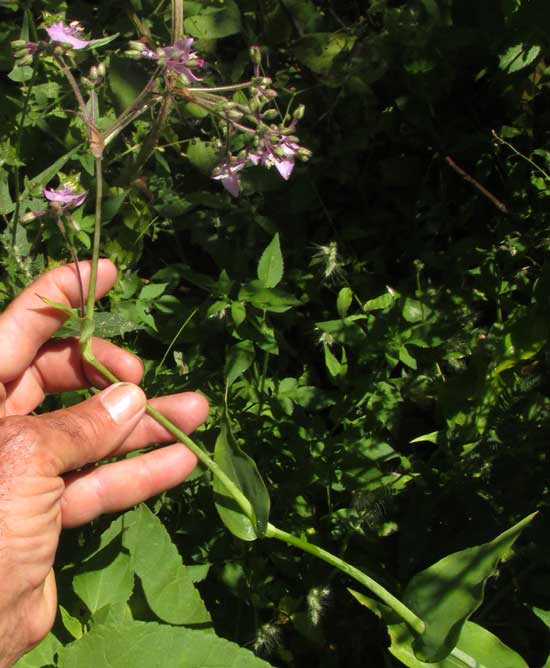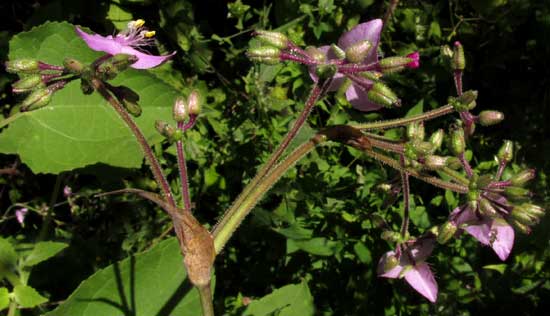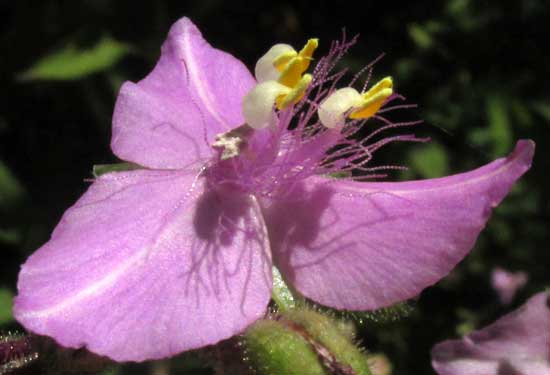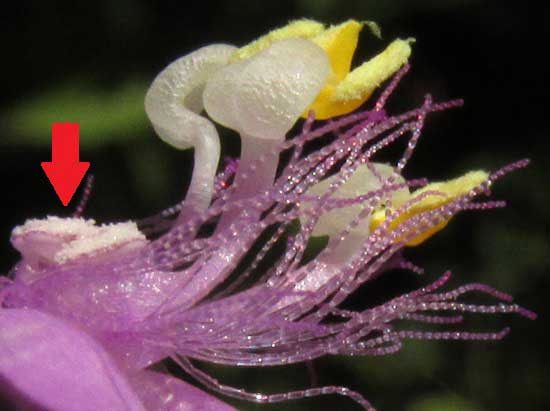Excerpts from Jim Conrad's
Naturalist Newsletter
from the December 10, 2017 Newsletter, with notes taken in mid October near Tepotzlán, Morelos state, MÉXICO
Elevation about 5315 ft (1620m), at 18°59′07″N 99°05′59″W
TRIPOGANDRA FLOWERING
During my mid-October visit with a friend near Tepotzlán, Morelos, in the uplands just south of Mexico City, a certain weed in a hedgerow between two ranchos caught my attention. It was a member of the Spiderwort Family, the Commelinaceae, and I'd been looking for species in that family because a doctoral candidate in São Paulo, Brazil studying the family has been asking for pictures of Mexican taxa. Below, you can see the flowering tip of one of the sprawling plant's branches:

Even from such a distance, northern wildflower fanciers will recognize this annual herb's similarity to the North's various spiderwort species, which sometimes are known as widow's tears because of the clear, mucilaginous juice that exudes from injured vegetative parts. The flower size and color are right, as are the teardrop-shaped leaves whose bases wrap around the stem. Below, a leaf-base close-up is shown:

Notice how the leaf base forms a short, silvery cylinder around the stem, before ending at the the stem node. Below, a close-up of the flowering head shows the inflorescence's peduncles and pedicels heavily invested with silvery hairs:

From behind, the corolla is seen expanding above three slender, glandular-hairy sepals, shown

What's really interesting, though, are the flowers' stamens, seen below:

Spiderwort blossoms bear six fertile stamens, but this flower produces only three fertile stamens, each bearing slender, conspicuously segmented hairs on their filaments, plus three sterile stamens, or staminodia, each with hairless filaments. Though otherwise the flowers look like typical spiderwort (genus Tradescantia) flowers, this plant's stamens are unusual enough to settle this species in a different genus. It's the genus Tripogandra, comprising about 22 species, none of which are native to North America, all being tropical American, with several species restricted just to Mexico. No accepted English name is applied to them, so I just call them Tripogandras.
The stamens are so unusual that it's worth looking at them close-up, as seen below:

The red arrow points to the fertile stamens' pollen-encrusted anthers. The fertile stamens' filaments are short, and hairy. The three conspicuous items with white "hoods" below what looks like yellow anthers are stamenodia. The "hoods" are known as filament inflations, and it's supposed they attract polliators. The yellow things are sterile "upper stamens." I didn't figure all this out myself but rather my Commelenaceae-specialist friend in São Paulo explained it to me, and even placed the red arrow on the image.
Of Mexico's several Tripogandra species, this one is distinguished by its smooth, shiny leaves, its rose-purple corolla, and especially by the particular structure of its stamens and staminodia . Our species is TRIPOGANDRA AMPLEXICAULIS, occurring in a variety of habitats but especially in weedy, disturbed places, and usually on loose, acid soils such as those developed atop Morelos's thick deposits of volcanic ash, through most of Mexico south to Nicaragua.